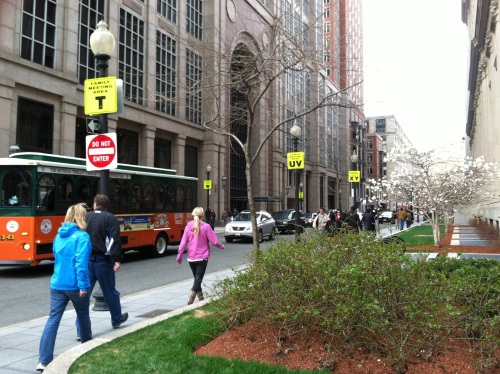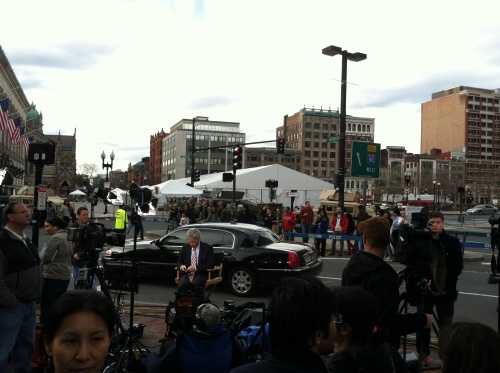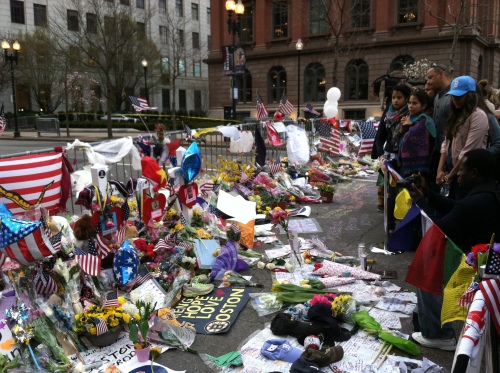All week I have been trying to look at the events unfolding here in Boston through the lens of city museums. Boston doesn’t have a proper city museum. If Boston did have a proper city museum, I would’ve wanted it this week to open wide its doors to the city for solace and reflection (many existing museums in Boston did in fact do so) and to serve as a place for civic dialogue while Bostonians struggled to understand and respond to the bombings, individually and collectively. I would’ve wanted it to collect and document the material culture of this event, and I would’ve wanted it to actively participate in city-wide efforts to interpret and memorialize the bombings.
Museum workers are not first responders—let’s be clear about that. But they are part of the second and third and fourth waves. They are public servants, and in times of crisis their job is to collect and document, tell the story, keep the memory, and help the public make meaning of it all. Boston doesn’t have a city museum to do that work right now. I am writing this post to call attention to what we are missing without one, and also to do my part as an urban public historian to capture and frame the details of what Bostonians experienced this week. Right now I’m not so concerned about the facts and timeline—plenty of people are recording and analyzing the chain of events. Rather I care about ordinary Bostonians: what they felt and expressed, and how they are integrating the bombings into their own personal narratives of the city.
As most of you know by now (if you didn’t know already), Marathon Monday always takes place on Patriots’ Day, which is a state holiday that commemorates the Battle of Lexington and Concord and the start of the American Revolution. It also launches April school vacation week and serves as Boston’s unofficial first day of spring. Every year on Marathon Monday thousands of Bostonians turn out to support and cheer on the runners along the course. And if they aren’t at the marathon, they’re at the Red Sox game or at gatherings of family and friends all over the city. For all these reasons Boston’s collective emotional barometer was particularly high on April 15 just before it sunk so precipitously.
As Bostonians tried to make sense of the bombings this week they turned to history for signs of past resilience: the city that withstood the Siege of Boston and “invented America,” the city that survived the Molasses Flood and the Big Dig. They turned to the brand Boston projects to the world to reassure themselves about the city’s essential character: John Winthrop’s city upon a hill, with one of the best medical communities in the country; a city that welcomes thousands of people from all over the world each year to its universities. They turned to Boston’s popular culture—Dirty Water, Cheers, Good Will Hunting—to express their love and fidelity. And they turned to Boston’s sports teams—the closest thing we have to urban warriors in 2013—for signs of continuity and strength. As they did so, Bostonians were not all on the same page about what constitutes an appropriate level of tolerance, empathy, or law and order; they were not all on the same page about how to mourn and when to get back to business as usual.
Every urban resident carries a mental map of their city inside their head. It’s how they navigate on a daily basis, and it’s layered with personal memories and landmarks. Most Bostonians had to look up Norfolk Street in Cambridge and Franklin Street in Watertown on Friday during the manhunt for suspect Dzhokhar Tsarnaev. No one had to look up the finish line stretch of Boylston Street where the bombings took place; it’s on every Bostonian’s mental map. They could instantly reel off the landmarks on those two blocks: the Copley Green Line station, Boston Public Library, Old South Church, the Lenox Hotel, Lord & Taylor, Marathon Sports. They could instantly recall years of personal memories—some mundane, some poignant—that were created there.
What a city museum would understand better than anyone else is that the bombings tore a hole in our mental maps. On Saturday afternoon I went down to the bombing site to try to get a handle on the exact nature of that hole. I took the Orange Line to Back Bay Station, walked up to the south side of Copley Square, and then skirted the southern and eastern edge of the secured crime scene perimeter. On one hand what I observed was comfortingly the same as always. The flower stall outside Back Bay Station was selling spring tulips in every color imaginable. The doormen at the Copley Plaza were at their post, greeting guests in tuxedos and evening gowns arriving for a wedding. Runners were running; college students were turning up for a Saturday night out on the town. The landmarks themselves—the library, the churches, the Hancock Tower, were all still there. On the other hand it was disturbingly, radically different. Even after the barricades are gone and the city returns to some version of normal, we need to remember that radical difference.
Every flag I saw was at half mast. Wolf Blitzer and a half-dozen TV journalists were broadcasting cheek-by-jowl on the corner outside the Copley Place Westin, lights blazing and TV trucks humming. Across the street from the news teams, roughly eight men in camouflage and bullet-proof vests, along with several armored jeeps, guarded the barricade at the southwest corner of Copley Square. By that point, with the threat to the city subsiding, they were spending most of their time making small talk with passersby, posing for pictures, and giving directions. Lots and lots of directions—many pedestrians were having trouble figuring out how to get where they were going without crossing Copley Square. A Boston traffic cop was also there directing cars that were having similar difficulty navigating around the hole in the city.
I walked east toward the corner of Clarendon and St James, where the lawn of Trinity Church was still strewn with plastic cups and marathon debris. No one had gotten around to removing the Family Meeting Area signs attached to the lampposts, one for each letter of the alphabet, that on Marathon Day give runners a way of finding their loved ones in the finish line crowd. At Boylston and Berkeley I stopped at the makeshift memorial and watched people pay their respects. Many of the items that had been placed there were still wet from that morning’s rain. Two older men were tending the memorial; one of them gave single yellow roses to kids in the crowd so they could lay them near the three crosses at the center of the memorial. Five or six therapy dogs were on hand and getting lots of attention.
I caught the Green Line at Arlington Station, heading outbound to a friend’s birthday party in Newton Centre. As the digital announcement system in my subway car flashed Entering Copley, we rode through but did not stop at Copley Station. The station was empty and dark except for a few dim security lights, still closed as part of the crime scene.
On Thursday night I talked with the students in my material culture course about the bombings and I asked them what they thought should be collected and preserved in order to capture the experience of Boston this week. With a few additional objects added in by me, their ideas included:
- Marathon medals, bib numbers, space blankets, and yellow runner bags
- The international flags from the finish line
- Yellow Boston Police and BAA Physician vests, marathon volunteer jackets, hospital equipment
- Bill Iffrig‘s orange singlet
- Carlos Arredondo’s bloodied American flag
- Martin Richard’s “No more hurting people. Peace” poster
- Signs and t-shirts of support—local, national, and international
- Slain MIT police officer Sean Collier’s uniform
- The makeshift memorial at Boylston and Berkeley
- Red Sox and Bruins memorial jerseys
- Mayor Tom Menino’s hospital bracelet
- The technology of the police investigation
- The recovered lid from the pressure cooker bomb
- The covered boat on Franklin Street in Watertown where suspect Dzhokhar Tsarnaev hid on Friday
- Photographs, video, news and social media feeds, oral histories, statements by public officials, luminaries, and celebrities
- The soundscape of the week: the typical happy sounds of the marathon (the starting gun, cheering spectators, cowbells) giving way to the explosion and confusion at the finish line; ambulances and helicopters, gunshots and house-to-house searches; and finally cheers of relief and gratitude as the second suspect was taken into custody
And this has been my growing concern throughout the week: that in the absence of a proper city museum, Boston is not prepared to document and collect this story. There is no museum in the city that has a mandate to collect contemporary Boston history. There are several institutions that will likely preserve paper records and photographs, but objects—particularly a collection of this scale—are another matter. I am reaching out to local colleagues to find out if efforts are underway that I just don’t know about yet, and if not, to see if something might be done.
I want to end by urging you to read a piece from today’s Boston Globe Ideas section by Stephen Heuser titled Vulnerability in an Open City. If I were planning an exhibition about the marathon bombings for a Boston city museum, this essay would be my compass. Heuser sets out to make larger points about social capital, openness, and risk that apply to any city, but he does it against the backdrop of Boston. In the process he captures in vivid detail the experience of everyday Bostonians this week. In his telling, we see the moral of this story and a value every city museum should hold: “cities bring us together in spite of ourselves.”


